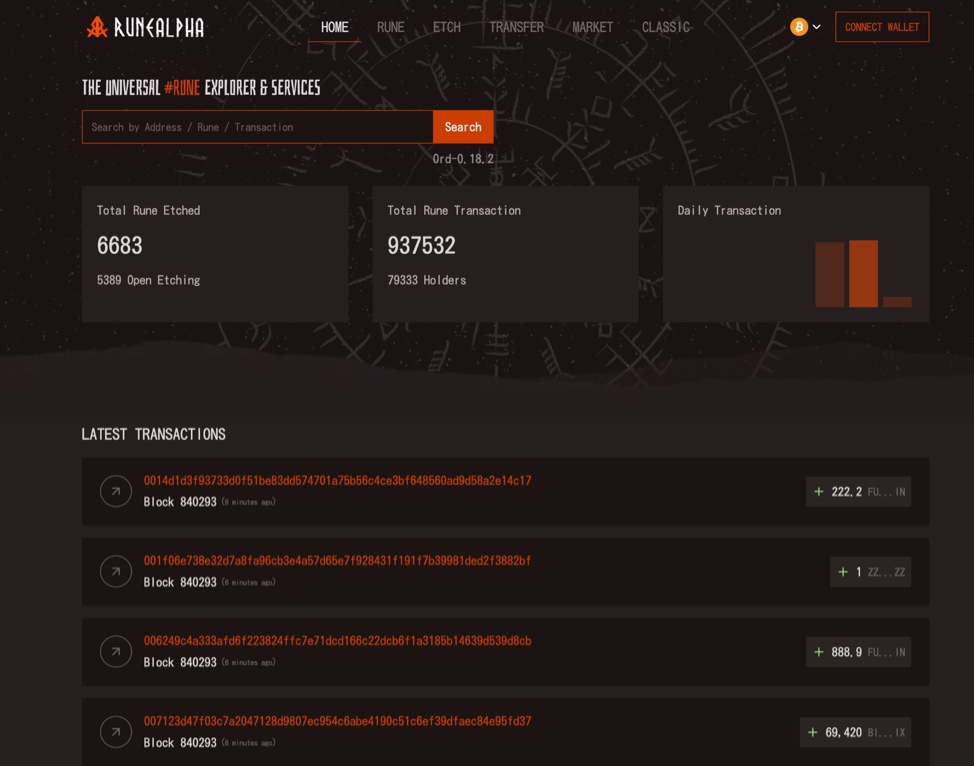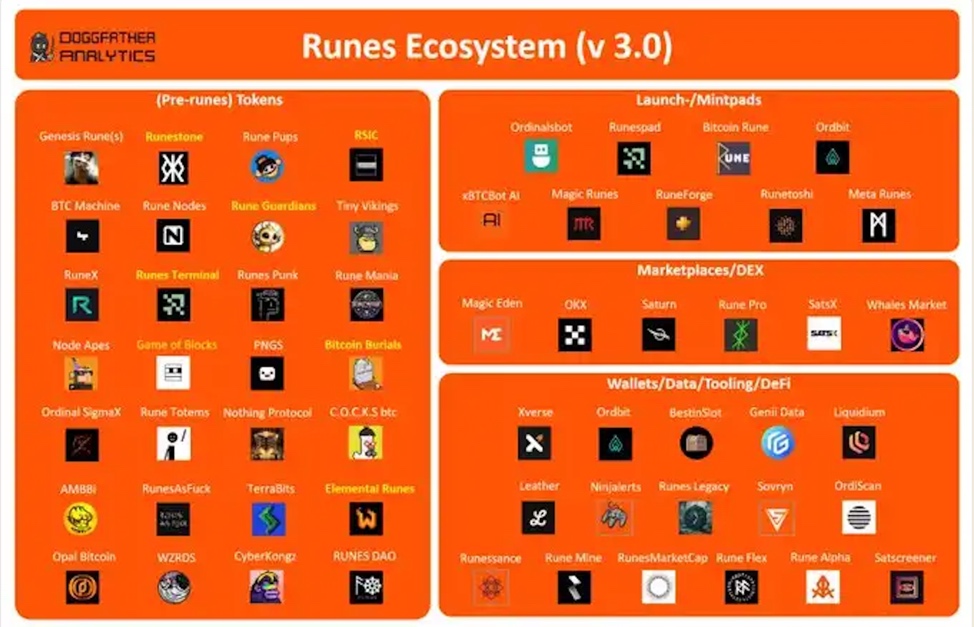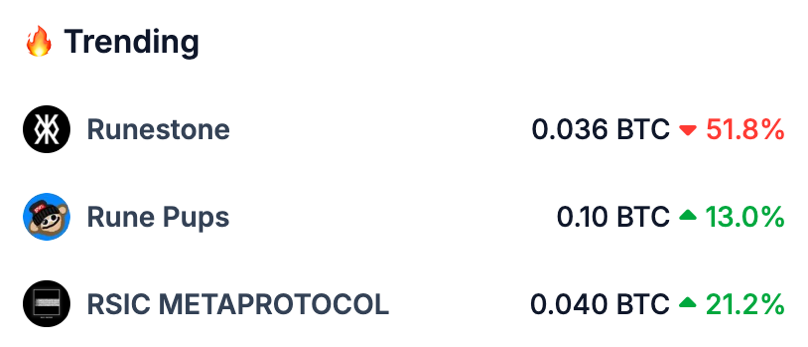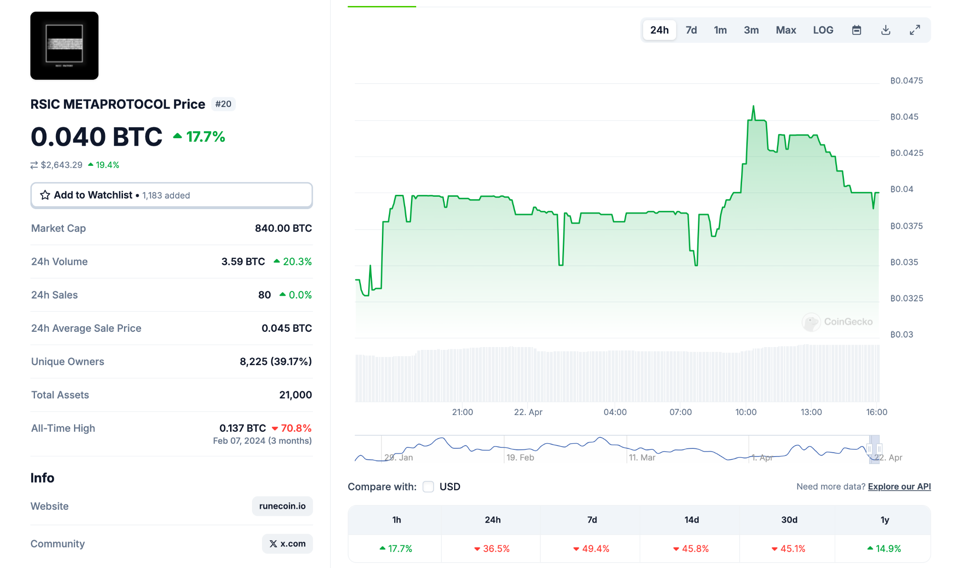What is the Runes Protocol? A Guide to Bitcoin's Latest Fungible Token Protocol
2024-04-25 06:16:00Key Points:
The Runes protocol offers a new method for issuing fungible tokens directly on the Bitcoin blockchain. It leverages a UTXO-based system that avoids the drawbacks of previous protocols like BRC-20.
Runes distinguishes itself by not requiring off-chain data and by minimizing on-chain footprints. This makes it more integrated and less burdensome on the Bitcoin network. This protocol allows for a variety of tokens to be managed in a single transaction, which simplifies the user experience and enhances transaction efficiency.
The Runes protocol has already begun to influence the market, evidenced by the creation and quick adoption of related projects like Runestone and RSIC. These developments signal a potentially significant shift in how digital assets are managed and traded on Bitcoin, with Runes enabling more scalable and diversified applications.
Introduction
Casey Rodarmor initially devised the Ordinals protocol with the aim of facilitating the upload of artwork/NFTs onto the blockchain, rather than focusing on coin issuance. However, the emergence of BRC-20 disrupted this intention, overshadowing the Ordinals in terms of transaction volume. Yet, the rapid rise of BRC-20 in two waves last year, coupled with the industry's acceptance of inscription tokens. Casey Rodarmor saw an opportunity to create a robust token protocol for Bitcoin that could not only generate substantial transaction fee revenue but also attract a broader community of developers and users, thus bolstering BTC's utility. Thus, on September 26, 2023, Casey Rodarmor unveiled the first comprehensive iteration of Runes.
Runes presents a departure from conventional asset issuance methods in Bitcoin. Unlike other protocols, the Runes eliminates the need for off-chain data or native tokens for issuance or transfer. Leveraging the unique structure of Unspent Transaction Outputs (UTXO) and its streamlined data storage, Runes leaves a significantly smaller footprint on the blockchain. Casey champions this enhanced system as a superior, leaner, and more straightforward asset issuance solution compared to the experimental BRC-20 protocol. Casey announced the official launch of the Runes protocol slated for late April 2024, coinciding with the coming of Bitcoin halving.
Following the introduction of the Bitcoin token standard by the pseudonymous developer Domo in March 2023, the BRC-20 token gained immense popularity. Within approximately three months, the value of BRC-20 tokens surged, reaching a staggering market capitalization of $1 billion. While the BRC-20 token standard allowed users to create alternative tokens native to Bitcoin for the first time, it also resulted in excessive production of "spam" UTXOs, causing network congestion. Casey Rodarmor is currently addressing this issue by developing a UTXO-based protocol aimed at preventing the generation of "junk" UTXOs.
What are Bitcoin Runes?
Bitcoin Runes emerges as an innovative approach to fungible tokens within the Bitcoin ecosystem, offering a compelling alternative to existing standards such as BRC-20 tokens. Powered by the Runes Ordinal Protocol conceptualized by Casey Rodarmor in September 2023, Bitcoin Runes presents a brand new solution to tokenization on the Bitcoin blockchain. Unlike its predecessors, Bitcoin Runes leverages the Runes Ordinal Protocol, designed to streamline token creation while addressing the limitations encountered with previous token standards. Casey Rodarmor's vision for the protocol was to introduce a simpler and more efficient alternative to the BRC-20 token standard, which initially pioneered fungible token creation on the Bitcoin network but suffered from issues like network congestion due to excessive 'junk' UTXOs.
The essence of the Runes protocol lies in its utilization of Unspent Transaction Outputs (UTXOs) within the Bitcoin blockchain to track and manage token balances. Each transaction involving Runes is meticulously structured. With different UTXOs representing varying amounts of Runes, this ensures a precise and transparent ledger of token ownership. Bitcoin Runes garnered significant attention and adoption within the Bitcoin community, evidenced by the issuance of the first RUNE token on the very day Casey Rodarmor unveiled the protocol's development. This enthusiastic response underscores the potential significance of Bitcoin Runes in revolutionizing tokenization within the Bitcoin ecosystem.
Advantages of the Runes Protocol on Bitcoin
The Runes protocol introduces a token standard tailored specifically for issuing fungible tokens on the Bitcoin blockchain, promising enhanced efficiency and functionality. Set to debut in April 2024 on block 840,000, coinciding with an anticipated Bitcoin halving, the protocol is poised to mark a significant milestone in the evolution of tokenization within the Bitcoin network.
The impetus behind the creation of the Runes protocol stems from the need for a more streamlined and UTXO-centric approach to tokenization on Bitcoin. Unlike the complex and resource-intensive nature of the BRC-20 token standard, Runes prioritizes the minimal on-chain footprint and responsible UTXO management. By mitigating issues such as network congestion caused by excessive junk UTXOs, Runes seeks to set a new standard for efficient and user-friendly token issuance on Bitcoin.
The Runes protocol distinguishes itself from existing fungible token protocols on Bitcoin, such as RGB and Taproot Assets, by eliminating reliance on off-chain data. While alternatives like Taproot Assets store metadata off-chain, potentially disconnecting asset information from Bitcoin's main layer, Runes remains firmly rooted within the Bitcoin blockchain, ensuring seamless integration and interoperability.
What Is the Difference Between BRC-20 Inscriptions and Runes?
The Runes protocol was introduced, initially without significant impact on the market. However, the recent emergence of Rune Alpha has altered this landscape, directly influencing market sentiment and inducing FOMO among users, potentially due to its name similarity with the Runes protocol. Despite Casey Rodarmor's clarification in his initial social media post that Rune Alpha is unrelated to his Runes, and the subsequent affirmation of independence by the Rune Alpha project, the issuance of the first COOK token by Rune Alpha still garnered considerable user interest, leading to frenzied minting activities.
This prompts inquiry into the distinction between inscriptions and runes from a technical standpoint. Directly citing Boss Cosine, a pivotal disparity between Bitcoin Inscription and Rune lies in their recording mechanisms: Inscription utilizes the Segregated Witness Data, while Rune employs OP_RETURN. While OP_RETURN faces limitations in data storage capacity, it suffices for token issuance purposes.
How does Runes Work?
Runes, an innovative protocol poised to revolutionize tokenization on the Bitcoin network, operates on the principles of utilizing unspent transaction outputs (UTXOs) – a foundational component of Bitcoin's architecture introduced by Satoshi Nakamoto. Building upon the success of Ordinals, Runes expands the concept of UTXOs by enabling users to maintain balances in various tokens within a single Rune, thereby facilitating the creation and transfer of tokens atop Bitcoin. This extension of the UTXO concept ensures that any remaining UTXOs after a transaction are destroyed, streamlining the process and enhancing efficiency.
Central to the functionality of Runes is the concept of Runestones, which serve as pointers to alternative outputs, rendering transactions non-spendable and thus disregarded by Bitcoin Core. By incorporating Runestones, users gain the flexibility to create new Runes, termed "Etchings," or to mint and transfer existing ones. This process is facilitated through a straightforward OP_RETURN-based protocol, characterized by approximately 2,000 lines of code, as succinctly articulated by Rodarmor, the mind behind the Runes protocol.
Etching marks the inaugural phase in crafting rune tokens, a pivotal process entailing the establishment of fundamental characteristics and governing rules such as divisibility and minting conditions. During this Etch phase, project owners hold the prerogative to execute a "Premine," whereby a portion of tokens is allocated to founders or initiators before public circulation commences. This allocation serves to kickstart project funding, compensate developers, or earmark tokens for community initiatives and targeted distributions.

Total Runes Etched, Source: Runealpha
Following the completion of etching, the subsequent stage is 'Minting,' wherein the creation of new tokens takes place. Minting protocols can either be open or closed, contingent upon conditions established during the etching phase:
Open Minting: Affording any eligible participant the opportunity to generate new tokens based on predefined criteria fosters active community engagement within the rune ecosystem.
Closed Minting: Restricted minting, wherein new tokens are only produced once specific predetermined conditions are met (e.g., reaching a certain token threshold or elapsing a designated time frame), effectively curtails token supply upon meeting these conditions.
To preempt VCs or project owners from pre-mining the initial runes, Casey Rodarmor opted to embed the first 10 runes (Rune 0 - Rune 9) directly into the rune protocol. This decision underscores a commitment to public minting exclusively, thereby ensuring universal participation within the public domain.
One of the fundamental advantages of Runes over existing standards such as BRC-20 lies in its simplicity and security. Unlike BRC-20, which limits users to transferring a single type of token to a singular destination with a lone inscription, Runes empowers users to distribute various tokens in a single transaction, offering unparalleled versatility. Casey Rodarmor emphasizes that Runes' streamlined approach not only enhances user experience but also addresses inherent limitations present in previous token standards like BRC-20, positioning it as a formidable contender in the realm of Bitcoin tokenization.
What Impact Will the Runes Agreement Have on the Bitcoin Ecosystem?
The Runes protocol will undoubtedly be more efficient and bring better scalability, enabling the creation of DeFi and other ecosystems based on Bitcoin. As we all know, in the past, Bitcoin has been unable to foster a thriving ecosystem like Ethereum due to its scalability problem. However, with the upgrade of BRC-20, ARC-20, and the Runes protocol, more DeFi ecosystems and user groups will emerge in the future.
Just as BRC-20 has produced million-dollar coins like Ordi, its upgraded version, Runes, is likely to produce similar tokens, thus amplifying the wealth effect of the Bitcoin ecosystem. Before the Runes protocol was officially launched, there were already several "cottage currencies" bearing the name of Runes, attempting to attract market capital by capitalizing on the hype.
Top and Popular Runes Projects to Invest in for 2024
As the Bitcoin halving happened on April 20, 2024, the excitement surrounding Bitcoin's Inscriptions and Runes projects is palpable. These projects are not only gaining momentum but are also showcasing the dynamic capabilities of the Bitcoin blockchain. This BTC price comes as Bitcoin surpasses its all-time high (ATH), partly driven by the anticipation surrounding the halving event and the introduction of spot BTC ETFs.
The spotlight is also intensifying on the Runes token protocol, which has been capturing significant interest due to its innovative approach to leveraging Bitcoin's infrastructure. Moreover, Bitcoin Inscriptions are creating a buzz as they offer a unique method for embedding data into the Bitcoin blockchain. This is achieved by inscribing digital art and other references into small Bitcoin transactions, akin to NFT-like assets. These digital assets, known as Inscriptions, are embedded in satoshis—the smallest denomination of Bitcoin.
» Further Reading: What Are Bitcoin Inscriptions and How Do They Work?
With the Bitcoin halving and the launch of the Runes protocol on April 20, it is crucial to keep an eye on the most promising Runes projects. Many of these projects are already planning to incorporate Runes tokens, blending innovation with investment potential. Here's a deeper dive into why these projects are attracting attention and which ones are worth your investment in 2024.

Runes Ecosystem, Source: Doggfather X post
Runestone: A Pioneering Ordinals Collection on Bitcoin
The Runestone project, initiated by Leonidas, the founder of @ord_io, represents a notable experimental endeavor in the digital assets realm. Runestone represents a significant innovation within the Bitcoin ecosystem, launched in March 2024. This project distinguishes itself by airdropping over 112,383 "Runestones" to early Bitcoin adopters, utilizing the Ordinals protocol to inscribe unique data onto individual Satoshis. The initiative not only underscores the community's support and commitment but also heightens anticipation across the Bitcoin community for the forthcoming launch of the Runes protocol.

Runestone 112,383 airdrop, Source:X tweet
While typical NFT projects maintain a total supply cap of around 10,000 units, Runestone's issuance exceeds this norm tenfold. The project's pivotal moment was marked by a snapshot taken at block height 826,600, coinciding with the first anniversary of the Ordinals' inception. Each Runestone serves as a unique collectible, solidifying its position in the digital asset space. The initiative emphasizes community by rewarding early participants in the Bitcoin network, ensuring transparency and fairness through the decentralized nature of its operations. With the impending launch of the Bitcoin Runes protocol and associated token airdrops, Runestone is poised at the forefront of the Ordinals movement, heralding a new era of community-focused digital assets.

Trending NFT after BTC halving, Source: CoinGecko
RSIC: Innovating Bitcoin Mining and Ordinal Inscriptions
Launched as a collection of 21,000 Ordinal inscriptions, RSIC is set to introduce the RUNE token. This project targets wallets holding specific Ordinal inscriptions, allowing users to 'mine' the upcoming tokens using their inscribed assets. RSIC stands out by leveraging unique Ordinals inscriptions to enable a new form of interaction within the Bitcoin blockchain. It represents an innovative approach to combining traditional mining concepts with the burgeoning field of Bitcoin Ordinals, thus fostering a new niche within the digital collectibles market.

RSIC NFT price, Source: CoinGecko
Will the 2024 Bitcoin Halving Trigger a Bull Market for Runes Projects?
Bitcoin heralded the era of decentralized digital currencies and payment systems. As the first cryptocurrency, Bitcoin marked a revolutionary departure from traditional financial and payment systems. Runes protocol represents a significant advancement in the ecosystem of fungible assets on Bitcoin, beginning with the introduction of the BRC-20 standard. Now, Runes is the next step in this pivotal development. The Runes protocol enhances transaction efficiency, user-friendliness, and compatibility with Bitcoin's UTXO system—attributes that were notably deficient in BRC-20 tokens.
The benefits of the Runes protocol could catalyze key use cases in the near future and beyond. Firstly, Runes could enable a functionally useful cryptocurrency ecosystem on Bitcoin. While the BRC-20 standard facilitated the creation of numerous tokens on the blockchain, most of these are merely novelty coins without practical applications beyond humor or crypto-themed satire. In contrast, the streamlined nature of Runes tokens and transactions could support the development of direct payment systems and solutions on Bitcoin. Promoting such payment activity could generate substantial transaction fee revenues and other benefits for operators adopting Runes technology. Secondly, integration with the Lightning Network and other Layer 2 scalability solutions for Bitcoin could allow Runes tokens to be used for cost-effective asset transfers across these platforms.
However, it's important to acknowledge the limitations shared by the Runes protocol and BRC-20, particularly the absence of smart contract functionality. Similar to the BRC-20 standard and the Ordinals protocol, Runes facilitates the manipulation of crypto-assets without smart contracts, a feature that Bitcoin inherently lacks. This limitation in programmability could restrict the potential applications of the Runes protocol. Overall, the impact of the Runes protocol on the Bitcoin ecosystem and its user community remains to be seen. The general consensus is that Runes represents a more ambitious development for the blockchain than both Ordinals and BRC-20.
Conclusion
The introduction of the Runes protocol by Casey Rodarmor is poised to redefine tokenization on the Bitcoin blockchain by addressing and improving upon the limitations encountered with previous standards like BRC-20. This innovative approach leverages a UTXO-centric method, eliminating the need for off-chain data and significantly reducing the blockchain's load through efficient management of transaction outputs. This not only ensures a minimal on-chain footprint but also enhances transaction efficiency and scalability within the network.
As Runes aligns with Bitcoin's inherent strengths and prepares for integration with key events like the Bitcoin halving, its potential to catalyze a new era of blockchain utility is substantial. The protocol's design to facilitate the creation and management of fungible tokens directly on the Bitcoin blockchain could attract a broader audience, ranging from developers to investors, thereby enriching the Bitcoin ecosystem with new applications and use cases. Furthermore, the early adoption and excitement surrounding associated projects such as Runestone and RSIC indicate a robust market interest and the potential for Runes to become a cornerstone in the digital asset space. These projects not only underscore the functionality and versatility of Runes but also highlight its capacity to support vibrant and dynamic digital economies.
FAQ
Q: What Is the Primary Difference Between BRC-20 and Runes?
A: The primary difference lies in their underlying technology and impact on the blockchain. BRC-20 depends on the ordinals protocol and has led to network congestion due to the excessive creation of junk UTXOs, whereas Runes uses a UTXO-centric approach that avoids such issues and does not require off-chain data.
Q: How Does the Runes Protocol Work?
A: Runes operates by utilizing Bitcoin's UTXO system to manage and track token balances. Transactions within this protocol involve various UTXOs representing different amounts of tokens, which allows for clear and efficient management of digital assets on the blockchain.
Q: What Potential Impact Could the Runes Protocol Have on the Bitcoin Ecosystem?
A: The Runes protocol could significantly enhance the efficiency and scalability of Bitcoin by facilitating the creation of a diverse range of fungible tokens directly on the blockchain. This could enable new DeFi applications and other ecosystems, expanding Bitcoin's use beyond just a currency to a broader platform for digital assets.
Q: What Are Some Popular Projects Associated With Runes?
A: Prominent projects include Runestone, which leverages the Ordinals protocol to issue unique collectibles, and RSIC, a collection of pixel art characters inscribed onto the Bitcoin blockchain, demonstrating the creative and investment potential of the Runes ecosystem.
Disclaimer: The information provided in this article is intended only for educational and reference purposes and should not be considered investment advice. For more information, please refer to here. Conduct your own research and seek advice from a professional financial advisor before making any investment decisions. FameEX is not liable for any direct or indirect losses incurred from the use of or reliance on the information in this article.